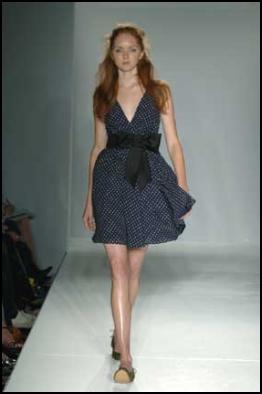
It’s worth noting that, bored, two nights before Karen Walker’s event, I watched the last two episodes of last year’s “America’s Top Model” back-to-back. I’d never seen it before. Actually, I watched the first episode and during the second episode when my favorite, Renee was disqualified for looking “too old,” (SERIOUSLY? She’s 20 years old!! She can’t even drink!! Yes, she’s a mom, but holy cow…) I let TiVo do its thing and only watched to see who won (thank goodness it wasn’t Natasha—what did they see in her? Jaslene was a godawful choice too—if she weighed 90 lbs, I’d be surprised, but she was better than the plastic-y Natasha).
I bring this up because after Karen Walker’s talk was over, a journalist who works for Wired Magazine asked her about the growing sentiment in the fashion world that runway models shouldn’t be too thin. And she totally flubbed the answer. I was nuts about her until she was forced to face that issue and the best that she could come up with was: “we hire models that make the clothes look good.” I thought it was a daring question—frankly one of the best audience questions I heard during the Idea Festival (where many questions were posed by people who’d clearly not been listening or by folks who had agendas). During her speech, a montage of her fashion shows played on screens behind her, and what made me nuts about her was the fact that she designed clothes that even I would be interested in wearing. But those clothes that I—short and less-than-svelte—could wear were on decidedly scrawny girls.
Karen Walker got her start eighteen years ago with $70 by designing a shirt and consigning it at a local boutique in New Zealand. Now she’s showing her collections at NY’s Fashion Week and at Fashion Weeks in London and Paris and Milan. She has a line of eyewear, jewelry, paint colors, and a lifestyle line. And her speech focused on the Karen Walker brand, and how despite the volatile nature of the fashion industry, she’s managed to build her brand and stay true to her vision. She was, in short, (and despite my feelings about her lack of answer to the model question) an ideal model for any entrepreneur.
Her speech outlined, basically, her secrets to success. The eight points were:
- Embrace volatility. Diversify; build your brand so it represents more than one thing, but don’t dilute your brand by offering it up to sub-quality knockoffs. In the 80’s and 90’s Gucci licensed its name to more than 200 different vendors and designers and lost control of its image. Brand-building is all about control.
- Ignore the rules; try not to learn them in the first place. She cited the NZ slang term “number eight wire” as being critical for her creativity. The term refers to a type of fencing wire that was readily available in colonial NZ, when it was cut off from most of the world—a sort of duct-tape like wire that allowed New Zealanders to cobble together all sorts of thing McGuyver-like. Make do with what you have, she said. It never occurred to her that she should have a design degree, she said, or a business degree before starting a business. Just go with what you have.
- Everything Inspires. This is a quote from Paul Smith, a British designer. And to illustrate this idea, she showed a slideshow of the random things that had inspired her last ten collections—everything from the eyewear of dictators around the world to Alice in Wonderland to B-movies from the 50’s.
- Look for the scary stuff. All design should make you border-line uncomfortable.
- Know your style. Coupled with the “scary stuff” she said this meant knowing “the right amount of wrong.”
- Know your customers. Walker has never done market research. She said to cater to the “same singular voices in everything you do.” She calls her market “PLU”—“people like us.” Her designs have been worn by celebrities as diverse as Bjork, Madonna, and Claire Danes, and she says she doesn’t design for a market, but designs what she likes and people who are like her will like what she does.
- Surround yourself with people who support you. A few years ago, she approached the makers of 42 degrees below vodka to cosponsor an event; they liked her designs so much they put her on the board. It’s since been sold to Bacardi (I think) and the mutual love-fest propelled both their brands.
- Brand building is like building coral. It’s slow and tedious and over the short-term, it’s hard to see. But take a step back and the growth is very clear.
No comments:
Post a Comment